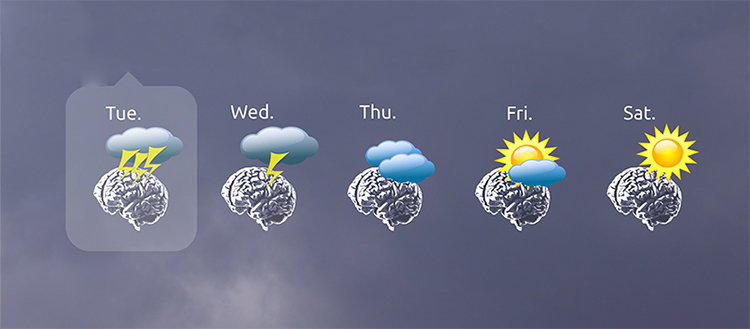A weather station for epileptic seizure
The unpredictability of epileptic seizures is a severe handicap for patients. Scientists have devised a technique that can predict seizure periods from one to several days in advance.

In common with weather disturbances, there are several time scales in epileptic brain activity. These can be used to predict the onset of a seizure one to several days in advance. © UNIGE/Mélanie Proix
A third of epilepsy sufferers are resistant to treatment for this neurological disease that affects 1% of the population. The onset of seizures is unpredictable, and has been the subject of fruitless research since the 1970s. The unforeseeable nature of the disease means patients are forced to take medication and / or adjust their lifestyles. Neuroscientists from the University of Geneva (UNIGE) and the University Hospital of Bern (Inselspital) – working with the University of California in San Francisco (UCSF) and Brown University in Providence – have succeeded in developing a technique that can predict seizures between one and several days in advance. By recording neuronal activity over at least six months using a device implanted directly in the brain, it is possible to detect individual cycles of epileptic activity and provide information about the probability of a future seizure. This approach, published in the journal Lancet Neurology, is remarkably reliable, and prospective clinical trials are now in the pipeline.
An epileptic brain can switch suddenly from a physiological state to a pathological state, characterised by a disturbance of neuronal activity which can cause, inter alia, convulsions typical of an epileptic seizure. How and why the brain swaps one state for another is still poorly understood, with the result that the onset of a seizure is difficult, if not impossible, to predict. «Specialists worldwide have been trying for over 50 years to predict seizures a few minutes in advance, but with limited success,» explains Timothée Proix, a researcher in the Department of Fundamental Neurosciences in UNIGE’s Faculty of Medicine. Seizures do not appear to be preceded by any obvious warning signs that would make prediction easier. The frequency, depending on the individual, varies from once a year to once a day.
«It’s a huge problem for patients», begins Maxime Baud, a neurologist at Inselspital. «This unpredictability is associated with a permanent threat that obliges patients to take medication on a daily basis. And in many cases, it prevents them from participating in certain sports. Living with this hanging over you can also affect your mental health». Existing treatments are often difficult to bear: they depend on drugs with numerous potential side effects to reduce neuronal excitability and sometimes involve neurosurgery to remove the epileptic focus, i.e. the starting point of the brain seizures. Moreover, a quarter of patients do not respond to these treatments, meaning they have to learn to manage the chronicity of their disease.
Weather forecasting
Epileptic activity can be measured using cerebral electrical activity data recorded by electroencephalography. This can be used to identify interictal discharges – evanescent discharges that appear in between seizures without directly causing them. «We observe clinically that epileptic seizures recur in clusters and cyclically. To ascertain whether the interictal discharges can explain these cycles and forecast the onset of a seizure, we analysed the data in greater detail», continues Dr Baud.
To do this, Baud collaborated with Vikram Rao, neurologist at UCSF, to obtain neuronal activity data collected over several years using devices implanted long-term in the brains of patients with epilepsy. After confirming that there were indeed cycles of cerebral epileptic activity, the scientists turned their attention to statistical analysis. This approach helped highlight a phenomenon known as the «pro-ictal state» where the probability of the onset of a seizure is high. «As with weather disturbances, there are several time scales in epileptic brain activity», points out Dr Baud. «The weather is influenced by the cycle of the seasons or day and night. On an intermediate scale, when a weather front approaches, the probability that it will rain increases for several days and is, therefore, better predictable. These three scales of cyclic regulation also exist for epilepsy.»
The right timeframe
The electrical activity in the brain is a reflection of the cellular activity of its neurons, more precisely their action potentials, electrical signals propagating along the neural network to transmit information. Action potentials are well known to neuroscientists, and their probability can be modelled using mathematical laws. «We adapted these mathematical models to the epileptic discharges to find out whether they heralded or inhibited a seizure», explains Dr Proix. To boost the predictive reliability, recordings of brain activity over very long periods were required. Using this approach, fronts with a high probability of seizure lasting several days could be determined for a majority of patients, making it possible to predict seizures several days in advance in some. With brain activity data collected over periods of at least six months, seizure prediction is informative for two-thirds of patients.
The analytical approach is sufficiently «light» to allow the transmission of data in real time on a server or directly on a microprocessor with a device small enough to be implanted in the skull. The researchers are now working in collaboration with the Wyss Center for Bio and Neuroengineering, based at Campus Biotech in Geneva, to develop a minimally invasive brain monitoring device to record the long-term data needed to forecast seizures. The device, which slips under the skin of the scalp, could give people with epilepsy the power to plan their lives according to the likelihood of having a seizure.
18 Dec 2020